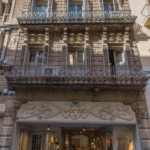At the end of the 19th century Reus was the second city of Catalonia in terms of population and economic activity, with a climate that favoured agriculture, a solid textile industry and a powerful trade based on brandy, to the point that the international pricing of this product was marked by the city together with Paris and London, hence the popular saying “Reus, Paris, London”. This resulted in the local bourgeoisie competing to build prestigious buildings and the urban image of the city was transformed.
The “modernist” imprint was given by Lluís Domènech i Montaner (1850-1923) when he lead the Institut Pere Mata project, a psychiatric hospital. Domènech designed a care center on the outskirts of the city, organized in independent pavilions separated by gardens, with a very careful use of the applied and decorative arts. The Institute is the direct precedent of the Hospital de la Santa Creu i Sant Pau in Barcelona.
From this moment on, Domènech i Montaner came into contact with Reus society who commissioned him works such as the Pere Rull’s house (1900), the Margenat family’s funeral chapel (c.1905), the house and oil warehouse of Fèlix Gasull (1910-1914), and the aborted projects for the Círcol Society (1899) and the Teatre Circ (1900). Among all these buildings, the Navàs Blasco house and shop (1901) stands out for its exceptionality, one of the few European houses that preserves in situ all the original furnishings, directed by the ensemblier Gaspar Homar. Domènech’s relationship with Reus continued with the works of his son, Pere Domènech Roura (1881-1967), author of the now-defunct Cinema Kursaal (1908-1909).
On the other hand, Antoni Gaudí (1852-1926) who was born in the city, did not leave any works, only a project to reform the Sanctuary of Mercy. There remain however, important constructions by two of his disciples, also sons of Reus: Joan Rubió i Bellver (1870-1853) and Domènec Sugrañes Gras (1878-1938), the latter with late constructions, already within the Noucentista period.
Finally, we cannot fail to mention the work of Pere Caselles i Tarrats (1864-1936) who was the municipal architect from 1891 to 1930 and is responsible for the largest number of modernist buildings that can still be seen in the city today.
| Image | artist | function | date |
|---|---|---|---|
| Lluís Domènech i Montaner | Architect | 1849-1923 | |
| Pere Caselles i Tarrats | Architect | 1864-1936 | |
| Joan Rubió i Bellver | Architect, archaeologist and politician | 1870-1952 | |
| Pere Domènech i Roura | Architect | 1881-1962 | |
| Domènec Sugrañes Gras | Architect | 1878-1938 |
| Cover | Author | Description | date | Link |
|---|---|---|---|---|
| Arnavat, A. | Reus 1900: Segona ciutat de Catalunya Fundació La Caixa ISBN: DL T. 1547-1998 |
|||
| Cabré, T. | Cabré, T. Editorial Mediterrània ISBN: 8483340593 |
|||
| J. Sardà et al | “Simposi Lluís Domènech i Montaner : ponències : Centre de Lectura de Reus, 6 i 7 d’octubre de 2017.” Centre D’Estudis Lluís Domènech i Montaner ISBN: 9788494923005 |
|||
| Arnavat, A.; Casamartina; J.; Freixa, M.; Gil, N.; March, J; Molet,J.; Sala, T.- M.; Saliné, M. Sardà, J.; Subías, P. |
La Casa Navàs de Lluís Domènech i Montaner Pragma edicions |
|||
| March, J. | Reus i el Modernisme Pragma edicions ISBN: 8493315125 |
|||
| March, J.; Freixa, M.; Gil, N.; Labad, A.; Sala, T-M.; Saliné, M.; Subias, P. | L’Institut Pere Mata de Reus de Lluís Domènech i Montaner Pragma edicions ISBN: 8493338583 |
|||
| Pitarch i Morell, Ma. T. | Reus ciutat modernista 1900-1910 Cambra de Comerç, Indústria i Navegació de Reus ISBN: 8460771806 |
Partner :
Reus – City Promot on Agency
C/ St. Joan, 34A – 43201 Reus, (Tarragona) – SPAIN
Contact person: Montserrat, Caelles Bertran
Phone: +34 977 010 667
Mail: mcaelles@reus.cat




























